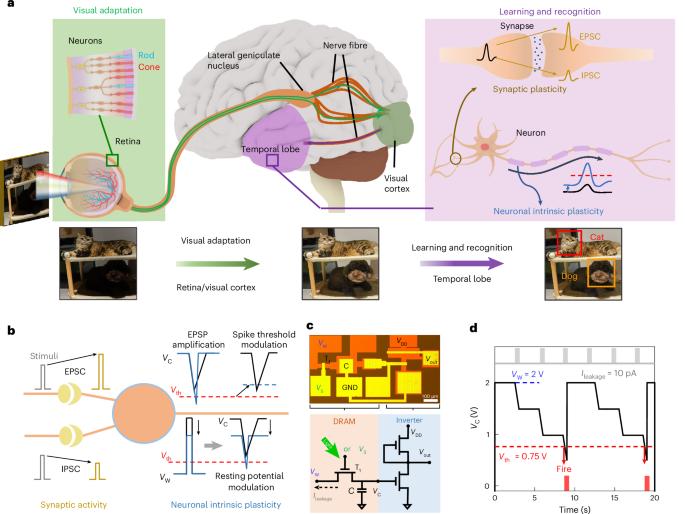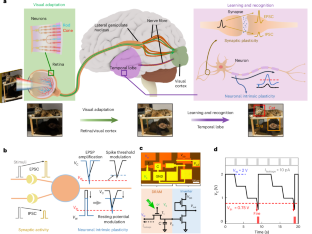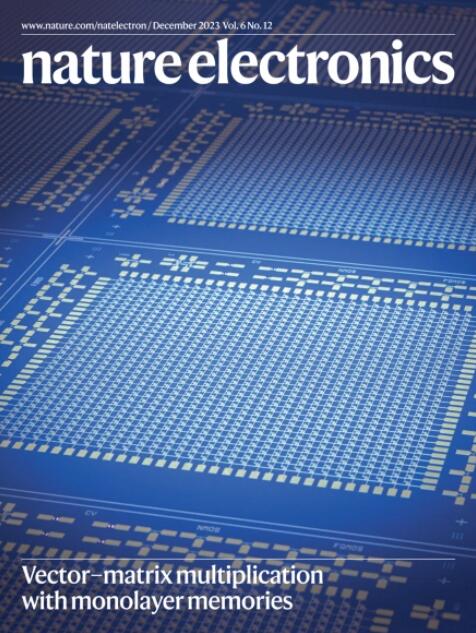基于单层二硫化钼的具有内在可塑性的仿生人工神经元
IF 40.9
1区 工程技术
Q1 ENGINEERING, ELECTRICAL & ELECTRONIC
引用次数: 0
摘要
精确模拟各种神经元行为的神经形态硬件可以用于边缘智能的开发。已经探索了结合突触可塑性(增强或减弱突触连接的适应性变化)的硬件,但模仿学习和记忆过程的全谱需要多种可塑性机制的相互作用,包括内在可塑性。在这里,我们展示了可以通过结合动态随机存取存储器和基于晶圆级单层二硫化钼薄膜的逆变器来创建集成和激活神经元。在该系统中,动态随机存取存储器电容中的电压(即神经元膜电位)可以被调制以模拟内在可塑性。该模块还可以通过动态调节其光敏度来模拟人类视觉系统的光性和暗性适应。我们制作了一个3 × 3感光神经元阵列,并演示了光编码和视觉适应。我们还使用神经元模块来模拟生物启发的图像识别神经网络模型。本文章由计算机程序翻译,如有差异,请以英文原文为准。


A biologically inspired artificial neuron with intrinsic plasticity based on monolayer molybdenum disulfide
Neuromorphic hardware that accurately simulates diverse neuronal behaviours could be of use in the development of edge intelligence. Hardware that incorporates synaptic plasticity—adaptive changes that strengthen or weaken synaptic connections—has been explored, but mimicking the full spectrum of learning and memory processes requires the interplay of multiple plasticity mechanisms including intrinsic plasticity. Here we show that an integrate-and-fire neuron can be created by combining a dynamic random-access memory and an inverter that are based on wafer-scale monolayer molybdenum disulfide films. In the system, the voltage in the dynamic random-access memory capacitor—that is, the neuronal membrane potential—can be modulated to emulate intrinsic plasticity. The module can also emulate the photopic and scotopic adaptation of the human visual system by dynamically adjusting its light sensitivity. We fabricate a 3 × 3 photoreceptor neuron array and demonstrate light coding and visual adaptation. We also use the neuron module to simulate a bioinspired neural network model for image recognition. An integrate-and-fire artificial neuron combining a dynamic random-access memory and an inverter based on wafer-scale monolayer molybdenum disulfide films can emulate intrinsic plasticity, the photopic and scotopic adaptation of the human visual system, and achieve temporal information encoding.
求助全文
通过发布文献求助,成功后即可免费获取论文全文。
去求助
来源期刊

Nature Electronics
Engineering-Electrical and Electronic Engineering
CiteScore
47.50
自引率
2.30%
发文量
159
期刊介绍:
Nature Electronics is a comprehensive journal that publishes both fundamental and applied research in the field of electronics. It encompasses a wide range of topics, including the study of new phenomena and devices, the design and construction of electronic circuits, and the practical applications of electronics. In addition, the journal explores the commercial and industrial aspects of electronics research.
The primary focus of Nature Electronics is on the development of technology and its potential impact on society. The journal incorporates the contributions of scientists, engineers, and industry professionals, offering a platform for their research findings. Moreover, Nature Electronics provides insightful commentary, thorough reviews, and analysis of the key issues that shape the field, as well as the technologies that are reshaping society.
Like all journals within the prestigious Nature brand, Nature Electronics upholds the highest standards of quality. It maintains a dedicated team of professional editors and follows a fair and rigorous peer-review process. The journal also ensures impeccable copy-editing and production, enabling swift publication. Additionally, Nature Electronics prides itself on its editorial independence, ensuring unbiased and impartial reporting.
In summary, Nature Electronics is a leading journal that publishes cutting-edge research in electronics. With its multidisciplinary approach and commitment to excellence, the journal serves as a valuable resource for scientists, engineers, and industry professionals seeking to stay at the forefront of advancements in the field.
 求助内容:
求助内容: 应助结果提醒方式:
应助结果提醒方式:


